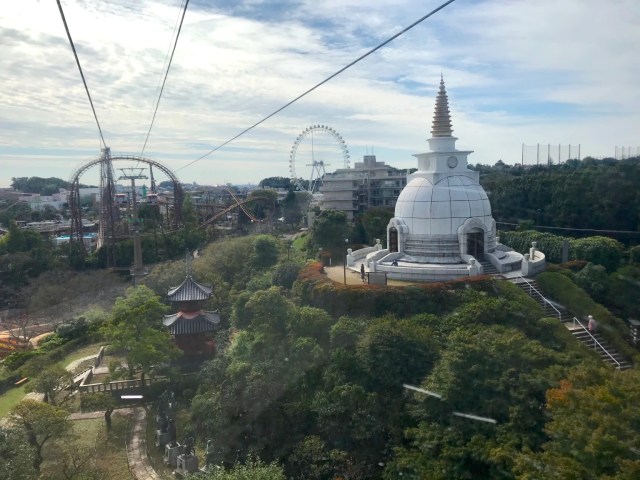
An enigmatic-looking building turns out to be much more.
Anyone who has ever been to the Tokyo amusement park Yomiuri Land might have spotted a white pagoda close by. If you’re making your way to Yomiuri Land from the train station, you might even mistake it for an attraction at the amusement park, but actually it’s a part of Hana Biyori, a flower park next to Yomiuri Land.
Actually, there are two pagodas in Hana Biyori, which opened in 2020 — a red one and a white one. Both pagodas have been there since Yomiuri Land opened back in 1964, but now are part of Hana Biyori, located in an area of the flower park called ‘the Sacred Forest’. Our reporter Mariko Ohanabatake decided to pay it a visit and and investigate further.
The Sacred Forest is certainly an unusual name for an area of a flower park, but Mariko soon found out that it was a fitting one. The white pagoda is made of Pakistani marble and called Shaka Nyorai-Den (or ‘Shaka Hall of the Buddha’). It is said that the hair (Śarīra) and bones (stupa) of the Buddha are enshrined within it. Śarīra is the term given to relics found in the cremated ashes of Buddhist spiritual masters, and stupa refers to a shrine containing the remains of a holy person. In other words, this pagoda was definitely a sacred place for those who practice Buddhism.
The stupa was enshrined in the former Mahintale Temple in Ceylon (present-day Sri Lanka), and was gifted to Japan by the Ceylon government in April 1964. Similarly, the Śarīra was enshrined in the Buddhist Monastari Temple in former East Pakistan (present-day Bangladesh), and was gifted to Japan in September 1964. It’s said to be extremely unusual to have both a stupa with the Buddha’s bones and Śarīra with sacred hair in the same spot.
It’s forbidden to take photos inside the pagoda, but Mariko spotted what looked like two golden bells inside the temple, which contained the holy relics.
The Sacred Forest is home to a whole bunch of other things to see as well, such as this statue of Myoken Bosatsu, also known as the God of the North Star. The statue was created in 1301 by the order of a Buddhist priest and was designated as an Important Cultural Property in 1950.
Myokan Bosatsu is said to bring blessings for maritime safety, marriage, safe childbirth, prosperous business, and good fortune. He’s also believed to be the Guardian of Horses, and in ancient times samurai prayed to him to provide them with good horses for battle.
▼ While it looks like the statue is doing a peace sign, it’s actually a sign meaning ‘sword’.
As well as the white pagoda, Hana Biyori’s Sacred Forest is also home to a red pagoda. The red pagoda is believed to have been built in the 17th century, and was moved near to Yomiuri Land in 1964.
But close to the red pagoda is another remarkable sight — the Statues of the Eight Patriarchs, eight figures believed to be founders of major Buddhist sects.
The statues were created by Sri Lankan sculptor Soma Pala, with former members of the Sculpture Department of the Japan Art Institute and feature Saicho of the Tendai sect, Kukai of the Shingon sect, Honen of the Jodo sect, Shinran of the Jodo Shin sect, Eisai of the Rinzai sect, Dogen of the Soto sect, Nichiren of the Nichiren sect, and Ryonin of the Yutsu Nembutsu sect. Mariko had read about these men in history books, and it was a real treat to see all eight of them here in one place.
Mariko couldn’t believe such a sacred place existed, and so close to a huge amusement park like Yomiuri Land. The vivid contrast between the red, Japanese style pagoda with the white bell shaped pagoda was so striking, Mariko felt like she was in a different time period, or even a different country. Not only that, but just a stone’s throw away, you can see rollercoasters and Ferris wheels from Yomiuri Land, and sometimes you can even hear cheering and screaming from the people riding them. It’s a surreal combination that feels like it’s from a comic book.
But why is there such a sacred area so close to Yomiuri Land? Well, the answer to that lies in the founder of Yomiuri Land, Matsutaro Shoriki. Shoriki, in addition to founding the Yomiuri Shinbun national newspaper, the Yomiuri Giants baseball team, and Nippon TV network, was a man of strong Buddhist faith, and as such created the Sacred Forest with Buddhist facilities when Yomiuri Land opened.
While Hana Biyori is technically part of Yomiuri Land, if you’re interested in visiting the Sacred Forest, you only need to purchase a ticket for Hana Biyori. Tickets are 1200 yen (US$9) for adults, but you can get a 200 yen discount if you order a ticket online.
Images: ©SoraNews24
● Want to hear about SoraNews24’s latest articles as soon as they’re published? Follow us on Facebook and Twitter!
[ Read in Japanese ]

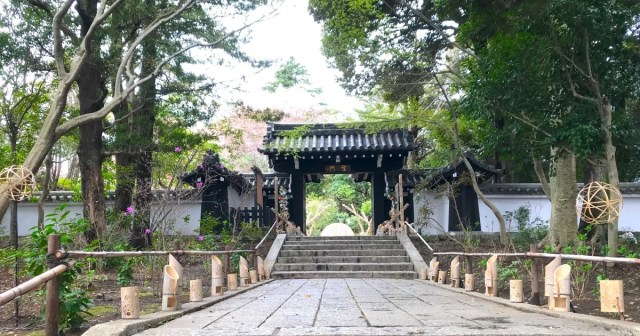
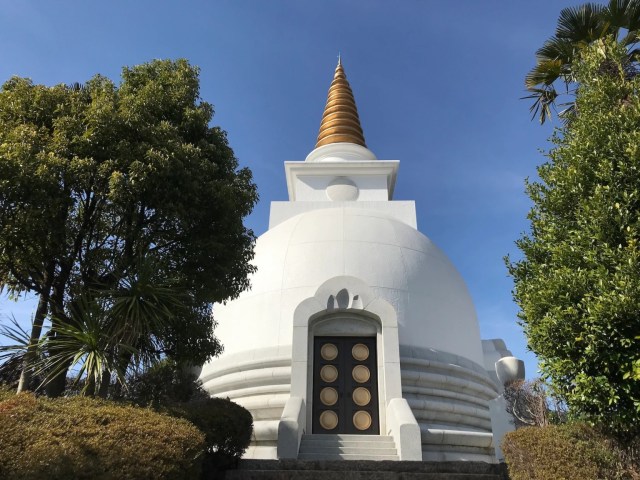
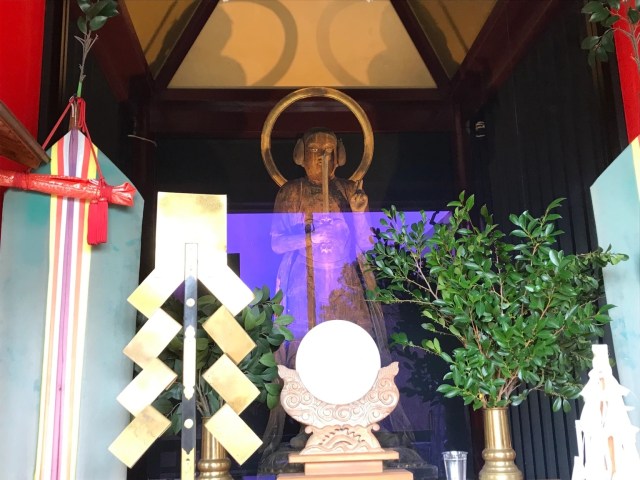



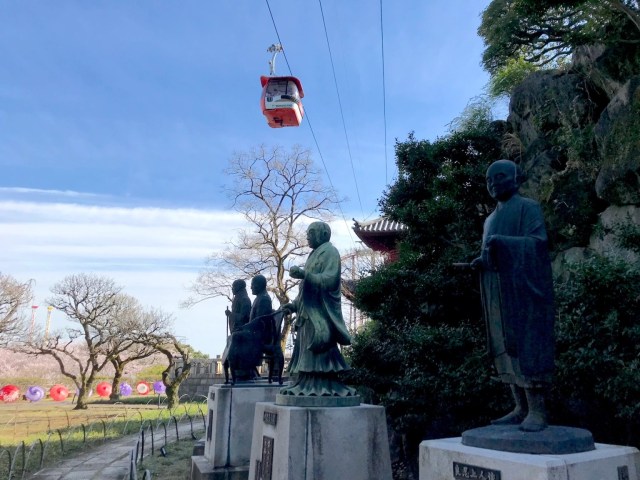
 Giant Buddhist pagoda and Kannon statue in Fukuoka Prefecture look like a theme park
Giant Buddhist pagoda and Kannon statue in Fukuoka Prefecture look like a theme park This little-known temple in rural Japan has a giant Buddha bigger than Kamakura’s or Nara’s【Pics】
This little-known temple in rural Japan has a giant Buddha bigger than Kamakura’s or Nara’s【Pics】 Earn points by visiting temples throughout Japan with Buddhist sect’s upcoming app
Earn points by visiting temples throughout Japan with Buddhist sect’s upcoming app Amazing pics from Kyoto/Nara “bullet tour” show no matter how tight your schedule, you should go
Amazing pics from Kyoto/Nara “bullet tour” show no matter how tight your schedule, you should go Japan Travel: Mysterious rockstar Jizo statue found at Kiyomizudera temple
Japan Travel: Mysterious rockstar Jizo statue found at Kiyomizudera temple Japan’s new difficult-to-drink-from beer glass protects your liver, but it’s a brutal experience
Japan’s new difficult-to-drink-from beer glass protects your liver, but it’s a brutal experience How to order snacks on a Shinkansen bullet train in Japan
How to order snacks on a Shinkansen bullet train in Japan New samurai glasses are Japan’s latest weird must-have souvenir
New samurai glasses are Japan’s latest weird must-have souvenir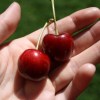 “Deflowering” services for virgin women are now a thing in Japan, apparently
“Deflowering” services for virgin women are now a thing in Japan, apparently Doraemon found buried at sea as scene from 1993 anime becomes real life【Photos】
Doraemon found buried at sea as scene from 1993 anime becomes real life【Photos】 Burger King Japan suddenly adds Dr. Pepper and Dr. Pepper floats to its menu nationwide
Burger King Japan suddenly adds Dr. Pepper and Dr. Pepper floats to its menu nationwide Hello, cosmetics! Clinique teams up with Hello Kitty this summer for first-time collaboration
Hello, cosmetics! Clinique teams up with Hello Kitty this summer for first-time collaboration Princesses, fruits, and blacksmiths: Study reveals the 30 most unusual family names in Japan
Princesses, fruits, and blacksmiths: Study reveals the 30 most unusual family names in Japan High-fashion Totoro cuddle purse is like an elegant stroll in the forest【Photos】
High-fashion Totoro cuddle purse is like an elegant stroll in the forest【Photos】 Demon Slayer: Kimetsu no Yaiba gets new roller coaster attractions and food at Universal Studios Japan
Demon Slayer: Kimetsu no Yaiba gets new roller coaster attractions and food at Universal Studios Japan Nintendo history you can feel – Super NES, N64, and GameCube controllers become capsule toys
Nintendo history you can feel – Super NES, N64, and GameCube controllers become capsule toys “The most Delicious Cup Noodle in history” – Japan’s French Cup Noodle wins our heart【Taste test】
“The most Delicious Cup Noodle in history” – Japan’s French Cup Noodle wins our heart【Taste test】 Starbucks releases a cute Frappuccino and Unicorn Cake…but not in Japan
Starbucks releases a cute Frappuccino and Unicorn Cake…but not in Japan Kyoto Tower mascot termination reveals dark side behind cute Japanese characters
Kyoto Tower mascot termination reveals dark side behind cute Japanese characters McDonald’s Japan’s Soft Twist Tower: A phantom ice cream only sold at select branches
McDonald’s Japan’s Soft Twist Tower: A phantom ice cream only sold at select branches Yabai Ramen: What makes this Japanese ramen so dangerous?
Yabai Ramen: What makes this Japanese ramen so dangerous? Finally! Nintendo Japan expands Switch 8-bit controller sales to everybody, Online member or not
Finally! Nintendo Japan expands Switch 8-bit controller sales to everybody, Online member or not Japanese government wants to build luxury resorts in all national parks for foreign tourists
Japanese government wants to build luxury resorts in all national parks for foreign tourists To combat declining birth rate, Japan to begin offering “Breeding Visas” to foreigners
To combat declining birth rate, Japan to begin offering “Breeding Visas” to foreigners 10 things you should buy at 7-Eleven in Japan
10 things you should buy at 7-Eleven in Japan Studio Ghibli releases anime heroine cosplay dresses that are super comfy to wear
Studio Ghibli releases anime heroine cosplay dresses that are super comfy to wear Woman charged for driving suitcase without a license in Osaka
Woman charged for driving suitcase without a license in Osaka Studio Ghibli unveils My Neighbour Totoro miniature house model
Studio Ghibli unveils My Neighbour Totoro miniature house model Kyoto experiencing problems with foreign tourists not paying for bus fares, but not on purpose
Kyoto experiencing problems with foreign tourists not paying for bus fares, but not on purpose Fighting mild hunger with a Japanese soda that turns into jelly in the stomach【Taste test】
Fighting mild hunger with a Japanese soda that turns into jelly in the stomach【Taste test】 Studio Ghibli’s Howl’s Moving Castle tapestry unveiled in Japan for first time
Studio Ghibli’s Howl’s Moving Castle tapestry unveiled in Japan for first time McDonald’s new Happy Meals offer up cute and practical Sanrio lifestyle goods
McDonald’s new Happy Meals offer up cute and practical Sanrio lifestyle goods Sales of Japan’s most convenient train ticket/shopping payment cards suspended indefinitely
Sales of Japan’s most convenient train ticket/shopping payment cards suspended indefinitely Sold-out Studio Ghibli desktop humidifiers are back so Totoro can help you through the dry season
Sold-out Studio Ghibli desktop humidifiers are back so Totoro can help you through the dry season Japanese government to make first change to romanization spelling rules since the 1950s
Japanese government to make first change to romanization spelling rules since the 1950s Foreigner’s request for help in Tokyo makes us sad for the state of society
Foreigner’s request for help in Tokyo makes us sad for the state of society Ghibli founders Toshio Suzuki and Hayao Miyazaki contribute to Japanese whisky Totoro label design
Ghibli founders Toshio Suzuki and Hayao Miyazaki contribute to Japanese whisky Totoro label design Tokyo’s most famous Starbucks is closed
Tokyo’s most famous Starbucks is closed Miss school field trips? Now adults can go on a “school trip” too with new plan at Nara hotel
Miss school field trips? Now adults can go on a “school trip” too with new plan at Nara hotel The most popular places in Japan for viewing sakura in 2024, according to local travel agency
The most popular places in Japan for viewing sakura in 2024, according to local travel agency Refresh your mind, body, and soul at Temple Camp Daitaiji, the first temple to open to campers
Refresh your mind, body, and soul at Temple Camp Daitaiji, the first temple to open to campers Mystery Tourist Spot: Merlions in Japan?
Mystery Tourist Spot: Merlions in Japan? TripAdvisor Japan announces the country’s 10 favorite shrines and temples
TripAdvisor Japan announces the country’s 10 favorite shrines and temples Should you get up early to see the sakura cherry blossoms in Tokyo?
Should you get up early to see the sakura cherry blossoms in Tokyo? Take it from a local: This resort island off the coast of Nagasaki is totally worth a side trip
Take it from a local: This resort island off the coast of Nagasaki is totally worth a side trip Add some Japanese architecture to your dinner table with beautiful pagoda dinnerware sets
Add some Japanese architecture to your dinner table with beautiful pagoda dinnerware sets This beautiful mountaintop Buddha carving in Japan is much newer than it looks【Photos】
This beautiful mountaintop Buddha carving in Japan is much newer than it looks【Photos】 Let’s learn how to sing “Jingle Bells” in Japanese with the help of Santa Pikachu!【Video】
Let’s learn how to sing “Jingle Bells” in Japanese with the help of Santa Pikachu!【Video】 We get a rare whiff of the corpse flower, a.k.a. the world’s stinkiest flower, in Tokyo botanical garden
We get a rare whiff of the corpse flower, a.k.a. the world’s stinkiest flower, in Tokyo botanical garden Real-world forest that inspired Hayao Miyazaki to create Totoro will become a nature preserve
Real-world forest that inspired Hayao Miyazaki to create Totoro will become a nature preserve Slice into a traditional sweet range with some of Japan’s most famous swords
Slice into a traditional sweet range with some of Japan’s most famous swords What’s this Tibetan temple doing in the middle of Japan? We go to find out!
What’s this Tibetan temple doing in the middle of Japan? We go to find out! The top five places to survive a real attack by Titans in Japan
The top five places to survive a real attack by Titans in Japan
Leave a Reply